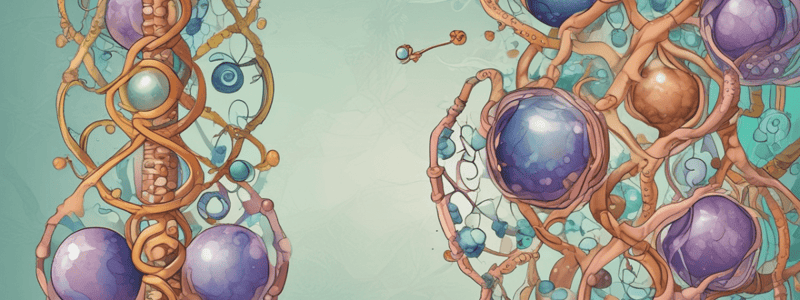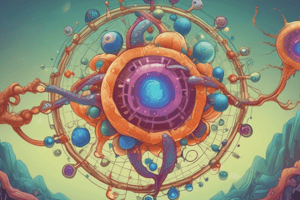Podcast
Questions and Answers
What is a characteristic of DNA in prokaryotes?
What is a characteristic of DNA in prokaryotes?
- It is tightly wrapped around histone proteins
- It is circular with no free ends (correct)
- It is linear with two free ends
- It is shorter than DNA in eukaryotes
What is the function of histone proteins in eukaryotes?
What is the function of histone proteins in eukaryotes?
- To provide structural support for chromosomes
- To increase the length of DNA
- To separate chromosomes during cell division
- To tightly wrap around DNA (correct)
What is the term for the two copied DNA molecules that remain attached at the centromere?
What is the term for the two copied DNA molecules that remain attached at the centromere?
- Homologous chromosomes
- Chromosomes
- Chromatids (correct)
- Sister chromatids
How many chromosomes are found in human cells?
How many chromosomes are found in human cells?
What is the term for the position of a gene on a chromosome?
What is the term for the position of a gene on a chromosome?
What is a result of random mutations in genes?
What is a result of random mutations in genes?
Flashcards are hidden until you start studying
Study Notes
Organization of DNA in Eukaryotic and Prokaryotic Cells
- In prokaryotes (e.g., bacteria), DNA is typically circular with no free ends, relatively short, and not bound to histones.
- In eukaryotes (e.g., humans), DNA is linear with two ends, longer, and tightly wrapped around histone proteins.
Structure of Chromosomes
- In eukaryotes, DNA is wrapped around histones, forming complex structures called chromosomes.
- Chromosomes are not found in prokaryotes since their DNA is not bound to histones.
Chromatin and Chromatids
- Before cell division, chromosomes are copied, and the two copies remain attached at the centromere.
- The two DNA molecules are called chromatids.
- At this stage, the whole structure is referred to as a chromosome.
Homologous Chromosomes
- In human cells, there are 46 chromosomes, with 23 coming from each parent.
- Homologous chromosome pairs have the same genes, but may have different alleles (versions) of those genes.
- The position of a gene on a chromosome is called the locus for that gene.
Genes and Alleles
- A gene is a section of DNA that encodes the amino acid sequence of a polypeptide.
- Random mutations can cause genes to occur in different versions, known as alleles.
- The blood group gene has three main alleles: A, B, and O.
Organization of DNA in Eukaryotic and Prokaryotic Cells
- Prokaryotic DNA is typically circular, relatively short, and not bound to histones.
- Eukaryotic DNA is linear, longer, and tightly wrapped around histone proteins.
Structure of Chromosomes
- In eukaryotes, DNA wraps around histones, forming complex structures called chromosomes.
- Chromosomes are absent in prokaryotes since their DNA is not bound to histones.
Chromatin and Chromatids
- Before cell division, chromosomes are copied, and the two copies remain attached at the centromere, forming chromatids.
- The entire structure, including the two chromatids, is referred to as a chromosome.
Homologous Chromosomes
- Human cells contain 46 chromosomes, with 23 coming from each parent.
- Homologous chromosome pairs have the same genes, but may have different alleles (versions) of those genes.
- The location of a gene on a chromosome is called the locus for that gene.
Genes and Alleles
- A gene is a section of DNA that encodes the amino acid sequence of a polypeptide.
- Random mutations can cause genes to occur in different versions, known as alleles.
- The blood group gene has three main alleles: A, B, and O.
Studying That Suits You
Use AI to generate personalized quizzes and flashcards to suit your learning preferences.




